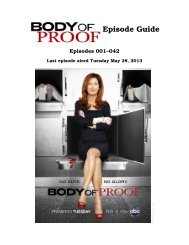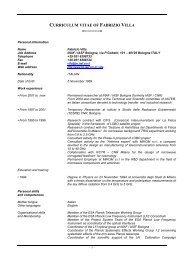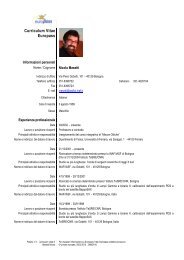Agatha Christie's Poirot Episode Guide - inaf iasf bologna
Agatha Christie's Poirot Episode Guide - inaf iasf bologna
Agatha Christie's Poirot Episode Guide - inaf iasf bologna
You also want an ePaper? Increase the reach of your titles
YUMPU automatically turns print PDFs into web optimized ePapers that Google loves.
<strong>Agatha</strong> Christie’s <strong>Poirot</strong> <strong>Episode</strong> <strong>Guide</strong><br />
Sir Roderick also contacts <strong>Poirot</strong> seeking help. He<br />
has lost letters written during the Second World War by<br />
a third party, which would now cause embarrassment<br />
should they be made public. <strong>Poirot</strong>’s attention attaches<br />
itself to Sir Roderick’s personal assistant, Sonia, who<br />
has apparently been passing secrets to a representative<br />
of the Herzogovinian [sic] Embassy at Kew Gardens.<br />
This is all a red herring, however: <strong>Poirot</strong> hints to Sonia<br />
that he knows of her espionage activities, and she abandons<br />
them in order to marry Sir Roderick instead at the<br />
end of the novel.<br />
Mrs. Oliver now provides <strong>Poirot</strong> with another key<br />
clue: she has heard while at Borodene Mansions that<br />
a woman, Louise Charpentier, has committed suicide<br />
by throwing herself out of the window of Flat 76. This,<br />
<strong>Poirot</strong> infers, must be the murder that Norma believed<br />
herself to have committed. Investigating the dead<br />
woman, he discovers that her real name was Louise<br />
Carpenter: also the name of a woman with whom Andrew<br />
Restarick had been in love many years earlier. Mrs.<br />
Oliver later even provides <strong>Poirot</strong> with the draft of a letter<br />
from Louise to Andrew in which she attempted to make<br />
contact once more: an item that had providentially come<br />
into her possession early in the novel when it fell from a<br />
drawer.<br />
Amongst other clues on which <strong>Poirot</strong> focuses, there are several that are only explained at the<br />
end of the book. Mary Restarick wears a wig, to which the reader’s attention is repeatedly drawn<br />
by the fact that Mrs. Oliver’s hairpieces are often mentioned as a plot device: indeed, Mrs. Oliver<br />
alters her hair in order to be in disguise when she sees Norma and David in the café. Also, <strong>Poirot</strong><br />
notices that there is a pair of portraits of Andrew Restarick and of his first wife (Norma’s mother)<br />
in their home; why is Mary Restarick apparently content to have a picture of her predecessor on<br />
display, and why does Andrew later split the set in order to have his own portrait in his office?<br />
Stillingfleet contacts <strong>Poirot</strong> to say that Norma has walked out on him unexpectedly. She has<br />
seen a message in the personal column of a newspaper calling her to the flat, where she is<br />
discovered by Frances Cary standing over the dead body of David Baker with a knife, the murder<br />
weapon, in her hand. Norma immediately claims responsibility for the murder to a neighbour,<br />
Miss Jacobs. Norma has, however, been subjected to a cocktail of drugs intended to disorient her<br />
and make her susceptible to the suggestion that she is a murderer.<br />
In the denouement <strong>Poirot</strong> reveals that the man posing as Andrew Restarick is an impostor,<br />
Robert Orwell, who has taken his place after the real Restarick died in Africa. Orwell has persuaded<br />
David Baker to paint a fake painting in style with the original one, which establishes to<br />
anyone who questions it that the new ’Restarick’ had looked much the same fifteen years earlier<br />
when the pair was painted. Mary Restarick, meanwhile, has been leading a double life, as both<br />
Mary and as Frances Cary, whom she could become by changing wigs. Their imposture, however,<br />
could be revealed by two people: by David Baker, who had taken to blackmailing Orwell over the<br />
picture; and Louise Carpenter, who knew Restarick too well to be fooled by Orwell. The murder<br />
plot involved killing both of them, and convincing Norma that she was the killer. Norma had<br />
never in reality been in Louise’s flat: they simply switched the 7 and the 6 on the door of her own<br />
flat. All along the ’third girl’ in the flat on whom attention should have been focused has been,<br />
not Norma, but Frances.<br />
At the end of the novel, Stillingfleet, who has staunchly defended Norma’s innocence even<br />
when it was most in question, is rewarded by her agreeing to marry him. As Mrs. Oliver realises,<br />
<strong>Poirot</strong> has planned this happy ending all along.<br />
162

















